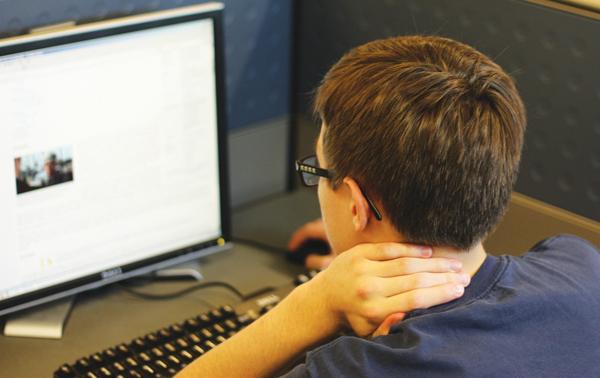
Many students have noticed a significant decrease in the speed of their Internet connections on campus this semester.
“My Internet speed has been, very, very, very slow,” said Danielle DeUrso, a sophomore majoring in history. “My Safari [Internet browser] freezes up pretty much every time I go on the computer. I’m in the same building as last semester, and it’s definitely much slower.”
James Alford, a sophomore majoring in mathematics, has had issues with slowed-down Internet access as well.
“I feel like the speeds are far slower than they were last year,” Alford said. “I have lag on my wireless Xbox connection that I didn’t have before.”
Mark Reed, associate vice president for Information Technology Services (ITS) at Binghamton University, said slower campus Internet connections are largely the result of Internet traffic increasingly shifting toward watching streaming video sites like YouTube, which has placed a strain on the campus network.
“Five years ago, [the Internet was being used for] a lot of emails and web pages and to download songs, which required a fair amount of bandwidth,” Reed said. “Now everything has become video, which is much more bandwidth intensive.”
Reed also attributed the problem to the increase in the number of devices besides computers connected to the campus network.
In addition to their personal computers, students now connect devices like smartphones, mp3 players and video game systems to the campus network.
“The number of students [on the network] is the same, but now everybody’s got five devices instead of one,” Reed said.
Stacey Troy, a sophomore majoring in actuarial science, has three Internet-connected devices: an Xbox, a laptop and an mp3 player.
Alford has five such devices: an Xbox, an iPod, a smartphone and two laptops.
Reed said the campus network is used most heavily from noon to 1 a.m., a trend that many students have observed.
“I’ve noticed that the Internet’s fine in the mornings, but at night, it’s dramatically slower,” Troy said. “Most times if it’s slow enough I’ll say ‘it’s not worth it’ and stop what I’m doing.”
Reed said the University’s technology equipment was in part to blame for slow connection speeds.
BU currently pays for the use of 570 megabits per second of data capacity, with the capability to pay to raise that to 1,000 megabits, or one gigabit, when necessary. Those 570 megabits have to be divided among everyone using the network.
“On a normal night, with 6,000 students using the network, we have to divide the network’s capacity by the 6,000,” Reed said. “The normal speed we allow people to go through is about 2 megabits per second of capacity.”
Reed said ITS has been actively working to make sure it keeps up with the campus’ Internet needs despite its limited budget. He said ITS has progressively increased the bandwidth from 200 to 570 megabits per second in the last year and a half, and it plans to raise the bandwidth to 700 megabits per second by the end of this year.
“We want to raise [the bandwidth] at a level that keeps response good, but doesn’t squander the money we have,” Reed said. “We’re always looking at the bandwidth issue. We notice that satisfaction with Information Technology Services is pretty directly linked to the performance of the network.”
Many students were prompted to revalidate their Internet-connected devices multiple times this semester. Typically students are only required to validate their devices at the beginning of each semester.
“I had to keep validating my Mac multiple times at the beginning of the year and my phone forces me to do it every once in a while as well,” Alford said.
Reed described the validation system as a tool implemented in 2004 to protect the network from widespread computer viruses and to help identify and assign network addresses to students’ devices.
According to Mike Hizny, assistant director of networking at ITS, there is a bug in the validation system currently that forces students to revalidate. He said ITS is working on fixing the bug, but it has not yet succeeded at pinpointing the cause.
“At this point, without there being a distinct set of circumstances between machines, there is no pattern so we can’t locate the source of the bug,” Hizny said. “There just hasn’t been enough data to actually break it down yet.”


